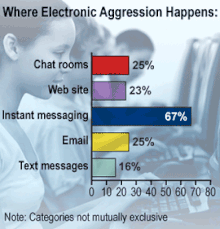Harassment
This article needs additional citations for verification. (May 2021) |
Harassment covers a wide range of behaviors of offensive nature. It is commonly understood as behavior that demeans, humiliates, and intimidates a person, and it is characteristically identified by its unlikelihood in terms of social and moral reasonableness. In the legal sense, these are behaviors that appear to be disturbing, upsetting, or threatening. Traditional forms evolve from discriminatory grounds, and have an effect of nullifying a person's rights or impairing a person from benefiting from their rights.[citation needed]
When harassing behaviors become repetitive, it is defined as bullying. The continuity or repetitiveness and the aspect of distressing, alarming or threatening may distinguish it from insult. It also constitutes a tactic of coercive control,[1] which may be deployed by an abuser in the context of domestic violence. Harassment is a specific form of discrimination,[2][3] and occurs when a person is the victim of unwanted intimidating, offensive, or humiliating behavior.
To qualify as harassment, there must be a connection between the harassing behavior and a person's protected personal characteristics or prohibited grounds of discrimination, and the harassment must occur in a protected area. Although harassment typically involves behavior that persists over time, serious and malicious one-off incidents are also considered harassment in some cases.
Etymology
[edit]
Attested in English from 1753,[4] harassment derives from the English verb harass plus the suffix -ment. The verb harass, in turn, is a loan word from the French, which was already attested in 1572 meaning torment, annoyance, bother, trouble[5] and later as of 1609 was also referred to the condition of being exhausted, overtired.[6][7] Of the French verb harasser itself there are the first records in a Latin to French translation of 1527 of Thucydides' History of the war that was between the Peloponnesians and the Athenians both in the countries of the Greeks and the Romans and the neighboring places wherein the translator writes harasser allegedly meaning harceler (to exhaust the enemy by repeated raids); and in the military chant Chanson du franc archer[8] of 1562, where the term is referred to a gaunt jument (de poil fauveau, tant maigre et harassée: of fawn horsehair, so meagre and …) where it is supposed that the verb is used meaning overtired.[9]
A hypothesis about the origin of the verb harasser is harace/harache, which was used in the 14th century in expressions like courre à la harache (to pursue) and prendre aucun par la harache (to take somebody under constraint).[10] The Französisches Etymologisches Wörterbuch, a German etymological dictionary of the French language (1922–2002) compares phonetically and syntactically both harace and harache to the interjection hare and haro by alleging a pejorative and augmentative form. The latter was an exclamation indicating distress and emergency (recorded since 1180) but is also reported later in 1529 in the expression crier haro sur (to arise indignation over somebody). hare's use is already reported in 1204 as an order to finish public activities as fairs or markets and later (1377) still as command but referred to dogs. This dictionary suggests a relation of haro/hare with the old lower Franconian *hara (here) (as by bringing a dog to heel).[11]
While the pejorative of an exclamation and in particular of such an exclamation is theoretically possible for the first word (harace) and maybe phonetically plausible for harache, a semantic, syntactic and phonetic similarity of the verb harasser as used in the first popular attestation (the chant mentioned above) with the word haras should be kept in mind: Already in 1160 haras indicated a group of horses constrained together for the purpose of reproduction and in 1280 it also indicated the enclosure facility itself, where those horses are constrained.[12] The origin itself of harass is thought to be the old Scandinavian hârr with the Romanic suffix –as, which meant grey or dimmish horsehair. Controversial is the etymological relation to the Arabic word for horse whose roman transliteration is faras.
Although the French origin of the word 'harassment' is beyond all question in the Oxford English Dictionary and those dictionaries basing on it, a supposed Old French verb harer should be the origin of the French verb harasser, despite the fact that this verb cannot be found in French etymologic dictionaries like that of the Centre national de resources textuelles et lexicales or the Trésor de la langue française informatisé (see also their corresponding websites as indicated in the interlinks); since the entry further alleges a derivation from hare, like in the mentioned German etymological dictionary of the French language a possible misprint of harer = har/ass/er = harasser is plausible or cannot be excluded. In those dictionaries the relationship with harassment were an interpretation of the interjection hare as to urge a dog to attack, despite the fact that it should indicate a shout to come and not to go (hare = hara = here; cf. above).[13][14][15] The American Heritage Dictionary prudently indicates this origin only as possible.
Types
[edit]Electronic
[edit]Electronic harassment is the unproven belief of the use of electromagnetic waves to harass a victim. Psychologists have identified evidence of auditory hallucinations, delusional disorders,[16] or other mental disorders in online communities supporting those who claim to be targeted.[17][18]
Landlord
[edit]Landlord harassment is the willing creation, by a landlord or his agents, of conditions that are uncomfortable for one or more tenants in order to induce willing abandonment of a rental contract. Such a strategy is often sought because it avoids costly legal expenses and potential problems with eviction. This kind of activity is common in regions where rent control laws exist, but which do not allow the direct extension of rent-controlled prices from one tenancy to the subsequent tenancy, thus allowing landlords to set higher prices. Landlord harassment carries specific legal penalties in some jurisdictions, but enforcement can be very difficult or even impossible in many circumstances. However, when a crime is committed in the process and motives similar to those described above are subsequently proven in court, then those motives may be considered an aggravating factor in many jurisdictions, thus subjecting the offender(s) to a stiffer sentence.
Online
[edit]
Harassment directs multiple repeating obscenities and derogatory comments at specific individuals focusing, for example, on the targets' race, religion, gender, nationality, disability, or sexual orientation. This often occurs in chat rooms, through newsgroups, and by sending hate e-mail to interested parties. This may also include stealing photos of the victim and their families, doctoring these photos in offensive ways, and then posting them on social media with the aim of causing emotional distress (see cyberbullying, cyberstalking, hate crime, online predator, Online Gender-Based Violence, and stalking).
Police
[edit]Unfair treatment conducted by law officials, including but not limited to excessive force, profiling, threats, coercion, and racial, ethnic, religious, gender/sexual, age, or other forms of discrimination.
Power
[edit]Power harassment is harassment or unwelcome attention of a political nature, often occurring in the environment of a workplace including hospitals, schools and universities. It includes a range of behavior from mild irritation and annoyances to serious abuses which can even involve forced activity beyond the boundaries of the job description. Power harassment is considered a form of illegal discrimination and is a form of political and psychological abuse, and bullying.
Psychological
[edit]This is humiliating, intimidating or abusive behavior which is often difficult to detect, leaving no evidence other than victim reports or complaints. This characteristically lowers a person's self-esteem or causes one to have overwhelming torment.[21] This can take the form of verbal comments, engineered episodes of intimidation, aggressive actions or repeated gestures. Falling into this category is workplace harassment by individuals or groups mobbing.
Racial
[edit]The targeting of an individual because of their race or ethnicity. The harassment may include words, deeds, and actions that are specifically designed to make the target feel degraded due to their race or ethnicity.
Religious
[edit]
Religious persecution is verbal, psychological or physical harassment against targets because they choose to practice a specific religion.[22] Religious abuse is abuse due to religious settings.[23] Religious harassment can include coercion into forced conversion.[24]
Sexual
[edit]Sexual harassment is an offensive or humiliating behavior that is related to a person's sex. It can be a subtle or overt sexual nature of a person (sexual annoyance,[25][26] e.g. flirting, expression of sexuality, etc.) that results in wrong communication or miscommunication, implied sexual conditions of a job (sexual coercion, etc.). It includes unwanted and unwelcome words, facial expressions, sexual attention, deeds, actions, symbols, or behaviors of a sexual nature that make the target feel uncomfortable. This can involve visual or suggestive looks or comments, staring at a person's body, or the showing of inappropriate photos.[27] It can happen anywhere, but is most common in the workplace, schools, and the military. Even if certain civility codes were relevant in the past, the changing cultural norms calls for policies to avoid intentional fallacies between sexes and among same sexes. Women are substantially more likely to be affected than men.[28][29] The main focus of groups working against sexual harassment has been the protection of women, but in recent years awareness has grown of the need to protect LGBTQ (for right of gender expression), transgender women and men.
Workplace
[edit]Workplace harassment is the offensive, belittling or threatening behavior directed at an individual worker or a group of workers.[30] Workplace harassment can be verbal, physical, sexual, racial, or bullying. [31]
Recently, matters of workplace harassment have gained interest among practitioners and researchers as it is becoming one of the most sensitive areas of effective workplace management. In some East Asian countries, it has attracted substantial attention from researchers and governments since the 1980s, because aggressive behaviors have become a significant source of work stress, as reported by employees.[32] Under occupational health and safety laws around the world,[33] workplace harassment and workplace bullying are identified as being core psychosocial hazards.[34]
Laws
[edit]The examples and perspective in this section may not represent a worldwide view of the subject. (August 2015) |
United States
[edit]Harassment, under the laws of the United States, is defined as any repeated or continuing uninvited contact that serves no useful purpose beyond creating alarm, annoyance, or emotional distress.[citation needed] In 1964, the United States Congress passed Title VII of the Civil Rights Act which prohibited discrimination at work on the basis of race, color, religion, national origin and sex. This later became the legal basis for early harassment law. The practice of developing workplace guidelines prohibiting harassment was pioneered in 1969, when the U.S. Department of Defense drafted a Human Goals Charter, establishing a policy of equal respect for both sexes. In Meritor Savings Bank v. Vinson, 477 U.S. 57 (1986): the U.S. Supreme Court recognized harassment suits against employers for promoting a sexually hostile work environment. In 2006, President George W. Bush signed a law which prohibited the transmission of annoying messages over the Internet (aka spamming) without disclosing the sender's true identity.[35] An important standard in U.S. federal harassment law is that to be unlawful, the offending behavior either must be "severe or pervasive enough to create a work environment that a reasonable person would consider intimidating, hostile, or abusive," or that enduring the offensive conduct becomes a condition of continued employment; e.g. if the employee is fired or threatened with firing upon reporting the conduct.[36]
New Jersey's Law Against Discrimination ("LAD")
[edit]The LAD prohibits employers from discriminating in any job-related action, including recruitment, interviewing, hiring, promotions, discharge, compensation and the terms, conditions and privileges of employment on the basis of any of the law's specified protected categories. These protected categories are race, creed, color, national origin, nationality, ancestry, age, sex (including pregnancy and sexual harassment), marital status, domestic partnership status, affectional or sexual orientation, atypical hereditary cellular or blood trait, genetic information, liability for military service, or mental or physical disability, including HIV/AIDS and related illnesses. The LAD prohibits intentional discrimination based on any of these characteristics. Intentional discrimination may take the form of differential treatment or statements and conduct that reflect discriminatory animus or bias.
Canada
[edit]In 1984, the Canadian Human Rights Act prohibited sexual harassment in workplaces under federal jurisdiction.
United Kingdom
[edit]In the UK, there are a number of laws protecting people from harassment, including the Protection from Harassment Act 1997 and the Criminal Justice and Public Order Act 1994.
See also
[edit]References
[edit]- ^ Crown Prosecution Service. "Controlling or Coercive Behaviour in an Intimate or Family Relationship | The Crown Prosecution Service". www.cps.gov.uk. Retrieved 3 October 2024.
- ^ "Harassment - Discrimination at work". Acas. 10 May 2023. Retrieved 3 October 2024.
- ^ "Definition of harassment, abuse and intimidation".
- ^ Oxford English Dictionary (online ed.). Oxford University Press. Retrieved 20 March 2021.
- ^ J. Amyot, Œuvres morales, p. 181
- ^ M. Lescarbot, Histoire de la Nouvelle France, I, 479
- ^ Etymology of harassement in the French etymologic dictionary CNRTL (in French)
- ^ The original text of the chant
- ^ Etymology of harasser in the French etymologic dictionary CNRTL (in French)
- ^ "Centre national de ressources textuelles et lexicales". Cnrtl.fr. Retrieved 22 July 2013.
- ^ Etymology of haro
- ^ Etymology of haras
- ^ "Harassment - Define Harassment at Dictionary.com". Dictionary.com.
- ^ "Online Etymology Dictionary". etymonline.com.
- ^ "Harass - Definition of harass by Merriam-Webster". merriam-webster.com.
- ^ Monroe, Angela (12 November 2012). "Electronic Harassment: Voices in My Mind". KMIR News. Archived from the original on 13 February 2014. Retrieved 25 February 2014.
- ^ Weinberger, Sharon (14 January 2007). "Mind Games". Washington Post. Retrieved 12 January 2014.
- ^ Olga Pochechueva. EMR Deliberately Directed At You — Moscow: LOOM Publishing, 2015 (in Russian). — 30 p. — ISBN 978-5-906072-09-2
- ^ Hertz, M. F.; David-Ferdon, C. (2008). Electronic Media and Youth Violence: A CDC Issue Brief for Educators and Caregivers (PDF). Atlanta (GA): Centers for Disease Control. p. 9. Archived from the original (PDF) on 26 September 2018. Retrieved 3 February 2015.
- ^ Ybarra, Michele L.; Diener-West, Marie; Leaf, Philip J. (December 2007). "Examining the overlap in internet harassment and school bullying: implications for school intervention". Journal of Adolescent Health. 41 (6 Suppl 1): S42–S50. doi:10.1016/j.jadohealth.2007.09.004. PMID 18047944.
- ^ Annette B. Roter (26 June 2017). Understanding and Recognizing Dysfunctional Leadership: The Impact of Dysfunctional Leadership on Organizations and Followers. Taylor & Francis. p. 161. ISBN 978-1-317-00517-9.
- ^ Grim, Brian J.; Finke, Roger (August 2007). "Religious Persecution in Cross-National Context: Clashing Civilizations or Regulated Religious Economies?". American Sociological Review. 72 (4): 633–658. doi:10.1177/000312240707200407. S2CID 145734744.
- ^ "Abuse in Religious Contexts". University of Kent. Retrieved 9 March 2023.
- ^ "International Standards on Freedom of Religion or Belief". Human Rights. United Nations.
1981 Declaration of the General Assembly Art. 1 (2), section Freedom from coercion
- ^ D., Woods, James (1993). The corporate closet : the professional lives of gay men in America. The Free Press. pp. 33+. ISBN 0-02-935603-2. OCLC 28183364.
{{cite book}}: CS1 maint: multiple names: authors list (link) - ^ Hearn, Jeff; Parkin, Wendy (1995). Sex at Work: The Power and Paradox of Organisation Sexuality. New York: St. Martin's Press. pp. 42+. ISBN 978-0-312-12957-6.
- ^ Kahsay, Woldegebriel Gebregziabher; Negarandeh, Reza; Dehghan Nayeri, Nahid; Hasanpour, Marzieh (13 July 2020). "Sexual harassment against female nurses: a systematic review". BMC Nursing. 19 (1): 58. doi:10.1186/s12912-020-00450-w. ISSN 1472-6955. PMC 7324991. PMID 32612455.
- ^ Maeve Duggan. PEW Research Center. 2014. "Online Harassment". "http://www.pewinternet.org/2014/10/22/online-harassment/".
- ^ "EEOC Home Page". www.eeoc.gov. Retrieved 29 April 2016.
- ^ "Maintaining a harassment-free workplace". Archived from the original on 28 March 2012. Retrieved 14 April 2014.
- ^ Harthi, Moussa; Olayan, Mohammed; Abugad, Hassan; Abdel Wahab, Moataza (1 December 2020). "Workplace violence among health-care workers in emergency departments of public hospitals in Dammam, Saudi Arabia". Eastern Mediterranean Health Journal. 26 (12): 1473–1481. doi:10.26719/emhj.20.069. ISSN 1020-3397. PMID 33355386. S2CID 226429852.
- ^ Tehrani, N. (2004), Bullying: A source of chronic post traumatic stress? British Journal of Guidance and Counseling, 32 (3), 357- 366
- ^ Concha-Barrientos, M., Imel, N.D., Driscoll, T., Steenland, N.K., Punnett, L., Fingerhut, M.A., Prüss-Üstün, A., Leigh, J., Tak, S.W., Corvalàn, C. (2004). Selected occupational risk factors. In M. Ezzati, A.D. Lopez, A. Rodgers & C.J.L. Murray (Eds.), Comparative Quantification of Health Risks. Geneva: World Health Organization.
- ^ "11. Psychosocial hazards" (PDF). Archived from the original (PDF) on 7 March 2014. Retrieved 7 March 2014.
- ^ McCullagh, Declan (9 January 2006). "Create an e-annoyance, go to jail". CNET news. Archived from the original on 15 March 2007.
- ^ "Harassment". www.eeoc.gov. Retrieved 6 June 2019.

